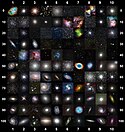No tricks, just treats (potm2310a)
(c) ESA/Webb, NASA & CSA, A. Adamo (Stockholm University) and the FEAST JWST team, CC BY 4.0
Autor/Urheber:
ESA/Webb, NASA & CSA, A. Adamo (Stockholm University) and the FEAST JWST team
Shortlink:
Quelle:
Größe:
4419 x 1399 Pixel (3120643 Bytes)
Beschreibung:
This month, Webb presents a spectacular treat… for the eyes. The barred spiral galaxy M83 is revealed in detail by the NASA/ESA/CSA James Webb Space Telescope. M83, which is also known as NGC 5236, was observed by Webb as part of a series of observations collectively titled Feedback in Emerging extrAgalactic Star clusTers, or FEAST. Another target of the FEAST observations, M51, was the subject of a previous Webb Picture of the Month. As with all six galaxies that comprise the FEAST sample, M83 and M51 were observed with both NIRCam and MIRI, two of the four instruments that are mounted on Webb.MIRI, or the Mid-InfraRed Instrument, makes observations in the mid-infrared, which spans wavelengths of light very different from optical wavelengths. Optical wavelengths in astronomy roughly correspond to the range of light waves that human eyes are sensitive to, and extend from about 0.38 to 0.75 micrometres (a micrometre, or micron, is one thousandth of a millimetre). By contrast, MIRI detects light from 5 to 28 micrometres — however, when it makes observations, it does not typically observe across this entire wavelength range all at once. Instead, MIRI has a set of ten filters that allow very specific regions of light through. For example, one of MIRI’s filters (dubbed F770W), allows light with wavelengths of 6.581 to 8.687 micrometres to pass through it. This image was compiled using data collected through just two of MIRI’s ten filters, near the short end of the instrument’s wavelength range. The result is this extraordinarily detailed image, with its creeping tendrils of gas, dust and stars. In this image, the bright blue shows the distribution of stars across the central part of the galaxy. The bright yellow regions that weave through the spiral arms indicate concentrations of active stellar nurseries, where new stars are forming. The orange-red areas indicate the distribution of a type of carbon-based compound known as polycyclic aromatic hydrocarbons (or PAHs) — the F770W filter, one of the two used here, is particularly suited to imaging these important molecules.[Image Description: A close-up view of a barred spiral galaxy. Two spiral arms reach horizontally away from the core in the centre, merging into a broad network of gas and dust which fills the image. This material glows brightest orange along the path of the arms, and is darker red across the rest of the galaxy. Through many gaps in the dust, countless tiny stars can be seen, most densely around the core.]
Lizenz:
Credit:
Relevante Bilder
Relevante Artikel
Messier 83Messier 83, manchmal auch südliche Feuerradgalaxie genannt, ist eine Spiralgalaxie im Sternbild Wasserschlange an der Grenze zur Jungfrau. Sie kann auf der Nordhalbkugel abends nur im Frühjahr beobachtet werden. .. weiterlesen





